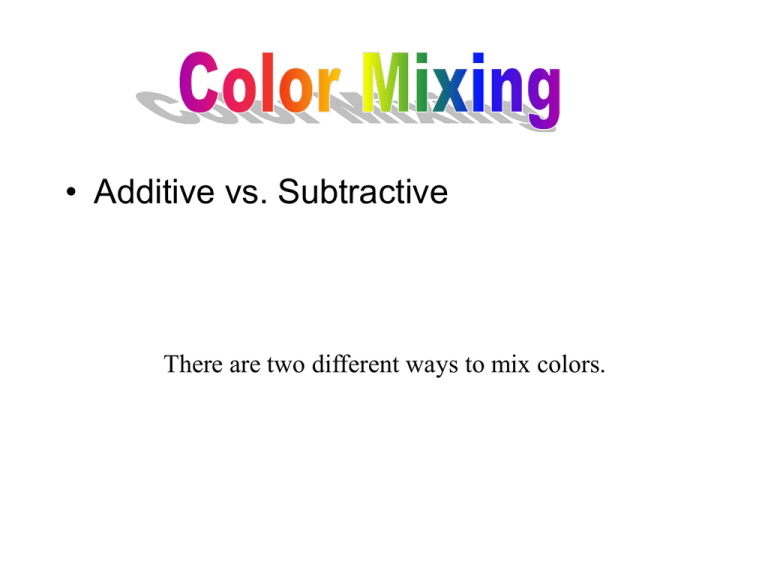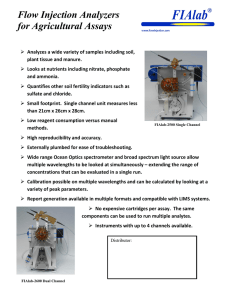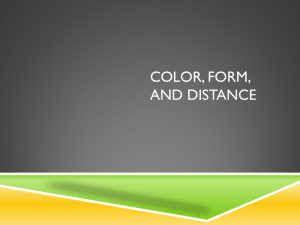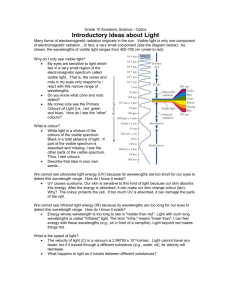• Additive vs. Subtractive
advertisement

• Additive vs. Subtractive There are two different ways to mix colors. • Additive vs. Subtractive What do you get if you use a prism to combine all wavelengths of light? • Additive vs. Subtractive What do you get if you use a prism to combine all wavelengths of light? • Additive vs. Subtractive What do you get if you mix a bunch of paint? • Additive vs. Subtractive What do you get if you mix a bunch of paint? • Additive vs. Subtractive • Additive mixing is most intuitive: ADD wavelengths: red+green = yellow red+blue = magenta blue+green = cyan red+green+blue=white Exploring Additive Mixing • use color sliders to adjust R,G,B values • What color can only exist as a metamer (an additive mixture of wavelengths)? In other words, what color cannot be made with a single wavelength? • What color can only exist as a metamer (an additive mixture of wavelengths)? In other words, what color cannot be made with a single wavelength? Magenta Think about why! • Subtractive mixing is much less intuitive (but much more common) • Subtractive mixing happens when we mix pigments (paint) together • Different pigments subtract different wavelengths: – red subtracts all but red, blue all but blue, green subtracts blue and red, etc… • Example: blue + yellow = green Technically it’s called “cyan” Amount of filtering • The result of a mixture depends on what wavelengths don’t get absorbed by the two pigments blue green yellow wavelength red Amount of filtering • Both yellow and blue pigments reflect a bit of green blue green yellow wavelength red • Subtractive mixing is commonly used in color printers Exploring Subtractive Mixing • use color sliders to adjust C, M, Y values • Everything you’ve learned so far is wrong. • Everything you’ve learned so far is wrong. • Well, not really wrong, just far from complete. What is color for? • What is color vision used for? What is color for? • What is color vision used for? – Identification - what is this thing? – Discrimination - what other things is this like? – Communication - indicates this thing to others What is color for? • What is color vision used for? – Identification - what is this thing? – Discrimination - what other things is this like? – Communication - indicates this thing to others • But in each case color refers not to the illuminating light, but to the surface of What is color for? • What is color vision used for? – Identification - what is this thing? – Discrimination - what other things is this like? – Communication - indicates this thing to others • But in each case color refers not to the illuminating light, but to the surface of Does the color of an object remain constant the object itself conditions? under different lighting What Newton Found (and everyone believed) • White light can be split into all wavelengths by a prism What Newton Found (and everyone believed) • White light can be split into all wavelengths by a prism • According to previous theories: two wavelengths combine to yield intermediate color and no others Red + Green = YELLOW What twist did Land do to this paradigm that confounds the conventional understanding of color mixing? What Land found: • Two bands (colors) of the spectrum recombine to produce all the possible colors – provided the appropriate relative amount of each wavelength is projected transparency slides How did Land project the “appropriate” ratio of wavelengths? Short- and Long- “record” • Capture two greyscale images of the scene using filters that allow only the film wavelengths you will project Camera “Long” filter Object “short” filter Projector “Long” filter “short” filter Image What is Land’s interpretation? How do we perceive color? Land’s interpretation: • perception of color is a weighing of the ratio of shorter and longer wavelengths Land’s interpretation: • perception of color is a weighing of the ratio of shorter and longer wavelengths Why would the visual system have this design? Why would the visual system have this design? • Hint: “Within broad limits, the actual values of the wavelengths make no difference, nor does the over-all available brightness of each” Color Constancy • The “color” of objects is independent of the ambient light – yellow bananas and green leaves look yellow and green regardless of whether they are viewed in direct sunlight or by the light of a fire Color Constancy • Land Mondrian: – demonstration of color constancy: all the wavelengths of the colored squares are shifted by the same amount into the blue end of the spectrum - your brain ignores the shift Color Constancy • Tricky question: – why does a window look blue from the outside when there’s a TV going inside? Color Constancy • Tricky question: – why does a window look blue from the outside when there’s a TV going inside? – The wavelengths emitted by a TV are mostly in the blue end of the spectrum Color Constancy • Really Tricky question: – why doesn’t a TV look blue? – Color Constancy causes you to perceive the areas of the screen with the greatest proportion of long wavelengths as “red”, the greatest proportion of short wavelengths as “blue” and everything else in between. Next Time • ATTENTION!




